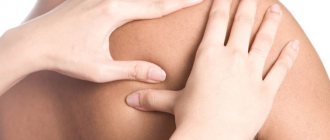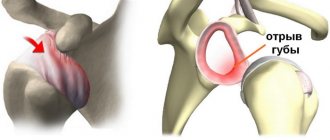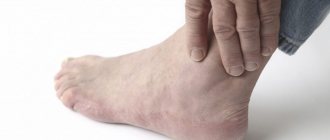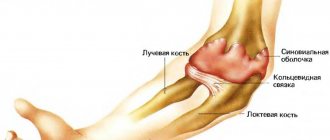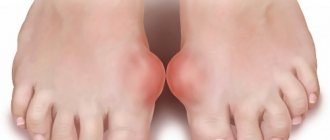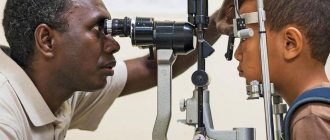Arthritis of the shoulder joint is a disease that results in inflammation, leading to degeneration and depletion of articular cartilage. Because of this, the performance of the shoulder joint and the arm as a whole deteriorates, and movements cause pain.
The shoulder joint is the most mobile joint in the human arm. Every day it bears a considerable share of the load, so it is easy to “break down”. However, it is not easy to immediately notice any disturbances in its functionality, since the disease, in the initial stages, has mild symptoms. But, as soon as doubts arise about the condition of the joint, you should consult a doctor without any delay. Advanced arthritis can lead to serious complications.
Reasons for development
Many patients are interested in how arthritis of the shoulder joint differs from arthrosis, because the symptoms of these diseases are very similar. Arthrosis is a degenerative disease in which the cartilage in the joint gradually wears out. And with arthritis, an inflammatory process occurs in the joint cavity.
Inflammation of the shoulder joint can be provoked by a variety of negative factors that affect the body from the inside and outside:
- passive lifestyle;
- heavy load on the shoulder, monotonous work;
- poor nutrition;
- diabetes;
- metabolic disease;
- shoulder injuries;
- infectious diseases;
- hypothermia;
- allergic reactions;
- autoimmune reaction;
- hereditary predisposition.
Depending on the cause of the disease, the following types of arthritis of the shoulder joint are distinguished:
- rheumatoid - autoimmune pathology;
- post-traumatic occurs during hard work and after injury;
- gouty is associated with metabolic disorders;
- psoriatic occurs against the background of psoriasis;
- Infectious arthritis develops when any pathogens enter the joint cavity.
Each type of arthritis requires specific treatment, which is why it is so important to get tested and make the correct diagnosis. Self-medication for joint inflammation can be fraught with serious complications.
Symptoms and first signs
A common symptom characteristic of all types of arthritis of the shoulder joint is severe pain, causing constant discomfort. Gradually the pain increases and prevents the movement of the arm.
There are other signs that suggest arthritis:
- Body temperature increases (this especially affects the affected area).
- The mobility of the arm is reduced, and it is difficult for the patient to lift it.
- Even a slight movement is accompanied by a specific crunch in the joint.
- Deterioration of general condition, chronic weakness.
- The appearance of swelling (typical of rheumatoid arthritis).
The acute form of the disease makes itself felt with sharp attacks of pain, while chronic arthritis can be asymptomatic.
When analyzing the symptoms of the disease, its stage is also taken into account:
- First stage. Aching pain that increases with exercise and subsides with rest. The intensity of pain depends on the time of day (intensified at night), and the current weather. The arm and shoulder get tired quickly.
- Second stage. The nature of the pain changes to a constant one; you cannot get rid of it with rest and reduction of stress. There is a feeling of stiffness, and a clicking sound is added when moving the hand.
- Third stage. Irreversible changes affect the articular tissues, causing deformation of the shoulder.
Diagnostics
To recognize arthritis of the joints, one examination is not enough. After examination with palpation and questioning to obtain a general picture of complaints, the patient is necessarily referred for additional diagnostic methods.
- X-ray. An X-ray will help to examine the location of arthritis, predict its development and assess the extent of the damage. There may also be foreign inclusions in the joint, which are clearly visible with high-quality digital radiography. From the image, you can determine the narrowing of the joint space, bone deformation and the formation of bone growths (osteophytes). Using this method, tumors, shoulder fractures, congenital pathologies, etc. are also excluded (or confirmed).
- Ultrasound. An ultrasound examination can determine the amount of damage in the joint and see if the synovium is damaged.
- Laboratory research. Blood tests and urine tests help determine the cause of shoulder arthritis (bacterial infections, etc.).
- Arthroscopy. Joint arthroscopy is a minimally invasive method of intervention for the purpose of accurately diagnosing intra-articular changes and their treatment.
Physiotherapy
Physiotherapy for arthritis of the shoulder joint successfully complements medications. All physiotherapeutic procedures are carried out in a medical institution or in a special center.
Let's look at some of the types of procedures, what each of them gives:
- Transcutaneous electrical nerve stimulation relieves pain that prevents the patient from sleeping and moving minimally.
- Ultraphonophoresis. Helps quickly deliver the active substance deep into the tissue (painless alternative to an injection). Laser phoresis also works.
- Magnetophoresis. Improves blood circulation and reduces swelling, increases mobility, has an analgesic effect, and accelerates recovery.
- Hirudotherapy (use of leeches). Improved blood supply.
Treatment of shoulder arthritis
Initial treatment for arthritis is always conservative. In the acute phase, a gentle regimen is recommended, a change in activity to eliminate situations that provoke pain, and in some cases, immobilization of the joint. Drug therapy is aimed at reducing the level of inflammation, eliminating the cause of arthritis, restoring the functions of the shoulder joint and includes the prescription of NSAIDs, analgesics, hormonal drugs, chondroprotectors, vitamins, etc.
Therapeutic punctures with intra-articular administration of diprospan and other glucocorticoids, hyaluronic acid preparations, and periarticular blockades are indicated. Conservative management of purulent arthritis includes antibiotic therapy, a series of therapeutic punctures with aspiration of pus, washing the cavity of the shoulder joint with antiseptics and the introduction of proteolytic enzymes into the cavity (joint lavage).
Along with medication, physiotherapy (SMT, UHF, magnetic therapy, laser therapy), balneotherapy, exercise therapy, massage, manual therapy, cryotherapy is used. In advanced and complicated arthritis, surgical treatment may be indicated: arthrotomy, resection of the shoulder joint, endoprosthetics (total arthroplasty or hemiarthroplasty), etc.
Nutrition and diet
Diet cannot be the only tool in the fight against shoulder arthritis. However, it has a positive effect on the patient’s immune system and speeds up the recovery process.
- What can't you eat? When drawing up a dietary menu, it is worth minimizing or completely abandoning salty, sweet and fatty foods. Flour products are also prohibited; the patient can only afford bread made from wholemeal flour. Alcoholic drinks that negatively affect the effectiveness of medications are strictly prohibited.
- What can you eat? The basis of the diet of a person suffering from arthritis should be vegetables and fruits (green, orange and yellow). You also need to add dairy products to your menu. Fish is extremely useful for the patient (salmon, tuna, and trout are especially valuable). It is best to concentrate on boiled and stewed foods, leaving fried foods until recovery.
- What can you drink? The patient needs to drink two liters of still water daily. Freshly squeezed juices will also benefit him.
Folk recipes
Arthritis of the shoulder joint can also be treated with folk remedies. They only need to be used after visiting a doctor and receiving appropriate recommendations from him.
Most of these prescriptions are aimed at eliminating the symptoms of the disease.
- Black currant leaves must be poured with boiling water and boiled in a water bath for 20 minutes. The finished folk remedy is taken several times a day.
- Birch buds are poured with boiling water and brought to a boil over low heat. After this, remove the broth and cover with a towel to infuse. Drink several times a day before meals.
- An effective folk remedy is burdock root. It should be thoroughly crushed and placed in an opaque container. Pour vodka and close the lid. The mixture is infused for a long time. The finished product is used to rub the sore joint.
Gymnastics
Some of the simplest and most effective exercise therapy exercises:
- Starting position – sitting or standing. Raise your right arm up, bend it at the elbow joint and place it behind your back, touching your shoulder blade. Count to 10 seconds while applying gentle pressure to your elbow with your other hand. Change hands. Repeat 5-8 times.
- Starting position – standing, feet shoulder-width apart. Place your hands so that the palm of your right hand is on the shoulder of your left and vice versa. Elbows spread to the sides. Try to grab yourself by the shoulders as tightly as possible, trying to reach your spine.
- Starting position – sitting or standing. Place your hands behind your head, clasp your fingers. In this position, perform shallow bends from side to side, trying to feel how the shoulder muscles stretch.
Folk remedies
Once you know the symptoms of shoulder arthritis, treatment can be done at home. Traditional medicine will help relieve pain and relieve inflammation. But not all methods are so good and safe. They can help some and harm others. Before using this or that product, you should consult your doctor.
Traditional medicine suggests using:
- Compresses:
- grate raw potatoes. Transfer the resulting mixture into a linen bag. Apply a compress to your shoulder for severe pain;
- soak a piece of cloth in fir oil and apply to the sore spot. Cover the top with film and wrap it with a scarf. Leave the compress on overnight;
- Spread a cabbage leaf with honey and apply it to the sore joint. Secure it with a bandage. You need to keep the compress for at least 2 hours.
When choosing traditional medicine methods, it is necessary to remember that the causes of the development of the disease are diverse.
- Ointments:
- melt 50 g of butter in a water bath. Add a pinch of lilac flowers. To harden, place the liquid in the refrigerator. You can apply the prepared ointment throughout the day;
- Mix 50 g of pork fat with 3 g of propolis until a homogeneous mass is obtained. Rub your shoulder morning and evening.
Folk remedies in combination with drug therapy are effective for arthritis at stages 1-2. At stages 3-4, high-tech treatment methods are used.
Complications of arthritis
- Long-term arthritis can lead to a disease such as adhesive capsulitis, or frozen shoulder syndrome. Inside the joint cavity, adhesions form between the walls of the capsule and it decreases. Capsulitis is characterized by aching pain and a decrease in the range of motion of the joint in all directions. If conservative therapy is not effective, arthroscopic surgery can be performed to stretch the joint capsule.
- Arthrosis of the joint is a degenerative disease in which the cartilage covering of the articular surfaces suffers: it becomes thinner, and bone growths appear. The patient complains of pain during exercise, crunching, clicking, and limited mobility. Untreated or repeated arthritis can lead to the development of arthrosis.
If even minor signs of shoulder joint pathology appear, do not expect them to go away over time, do not self-medicate, consult a specialist.
Prognosis and prevention
If left untreated, arthritis of the shoulder joint severely limits or even eliminates the mobility of the shoulder girdle and upper limb, seriously impairing the patient's quality of life. In severe cases, the only treatment option is an expensive operation with a long rehabilitation period, so it is extremely important to recognize the first signs of the disease in time and begin therapy at an early stage.
Prevention of arthritis is facilitated by the elimination of increased physical activity and injuries to the shoulder joint, timely treatment of concomitant diseases, and a balanced diet.
Kinds
The arthritic pathological process has several varieties in accordance with the characteristics of its course:
- post-traumatic arthritis. The disease occurs in people who have a history of dislocations, fractures and injuries;
- osteoarthritis. The disease develops when tissues age and wear out, causing the destruction of articular cartilage. In most cases, the disease is diagnosed in elderly loaders and athletes;
- rheumatoid arthritis. This form of the disease is difficult to treat. Rheumatoid arthritis affects the connective tissue in the upper shoulder girdle. With pathology, not only the cartilage becomes inflamed, but also the entire shoulder joint.
Types of arthritis
How is arthritis treated? First, its type must be determined, which makes it possible to develop an effective treatment regimen.
